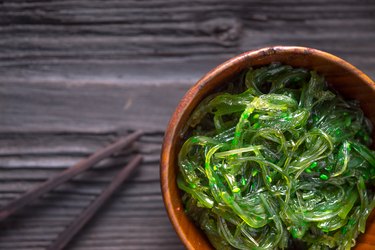
Seaweed salad is a tasty dish that has a lot of important nutrients. Typically made with a type of seaweed called wakame, it contains multiple vitamins and minerals, as well as healthy fatty acids. The only negative is the high sodium content, which is typical of marine plants.
Tip
Seaweed salad is typically made with wakame, soy sauce, vinegar, sesame oil and sesame seeds. Wakame is full of beneficial vitamins, minerals and healthy fatty acids.
Video of the Day
Nutrients in Seaweed
There are quite a few types of seaweed that can be used in seaweed salad. These include:
Video of the Day
- Arame, which looks like black vermicelli noodles.
- Dulse, which is chewy, like fruit jerky.
- Irish moss, which looks like curly lettuce.
- Nori, which is popular in Japanese cuisine and used in sushi.
- Sea palm, which only grows in western North America.
- Wakame, the traditional ingredient used to make seaweed salad.
These types of seaweed all differ in flavor and nutrient content. According to the USDA National Nutrient Database, seaweed is known for having vitamins A, C, K and various B-complex vitamins. It also offers calcium, iron, manganese, magnesium, phosphorus, potassium, selenium, sodium and zinc. Seaweed is particularly rich in fiber, protein and omega-3 fatty acids called EPA. All of these nutrients are beneficial, making seaweed highly nutritious.
What's in Seaweed Salad?
Seaweed salad is often known as goma wakame or sesame wakame salad. It's traditionally made with wakame seaweed, but you can incorporate other types of seaweed, vegetables, avocado or even cold noodles if you want. To make a basic seaweed salad, you need wakame seaweed, rice-wine vinegar, soy sauce, sesame oil and sesame seeds. Because wakame seaweed is so high in sodium and you're adding soy sauce, you only need a sprinkle of salt, or better yet omit it all together. You may also want a bit of sugar, or alternatively, mirin.
Wakame seaweed is typically sold in dried form. If dried, it needs to be rehydrated before it can be a part of a salad. This is easy — just take the dried seaweed and let it sit in water for five to 10 minutes while it gets soft. To make seaweed salad, mix the vinegar, soy sauce and oil to make a vinaigrette. Add salt and sugar or mirin to taste, then mix the rehydrated seaweed into the completed vinaigrette. Just sprinkle on some sesame seeds and you have yourself a basic seaweed salad.
If you're interested in a more complex recipe, try incorporating other types of seaweed, like dulse or arame, into your salad. Sea vegetables like samphire, ogo-nori or sea grapes (also known as umibudo) are also often incorporated into salads. Alternatively, add some avocado, carrot, cucumber, onion or radish to increase the range of vitamins and minerals you're eating.
Is Seaweed Salad Healthy?
With so many different vitamins and minerals, seaweed is certainly a healthy food. Alone, 100 grams of wakame seaweed, which is equal to 1 1/4 cup, can provide you with 12 percent of your daily recommended allowance of calcium and iron, 25 percent of magnesium, 32 percent of copper, and 61 percent of manganese. Wakame can also provide you with 12 percent of your daily recommended allowance of vitamin A, 18 percent of vitamin B-2, 14 percent of vitamin B-5 and 49 percent of vitamin B-9. This means that in general, seaweed salad that is primarily made of raw wakame is healthy. Of course, the ultimate nutritional content of seaweed salad will depend on what you add to it. A seaweed salad with extra vermicelli noodles, soy sauce and sugar may not be as good for you as one with avocado, cucumber and a low-sodium soy dressing.
The main thing you should watch out for with seaweed salad is the high sodium content. There are 872 milligrams of sodium in 100 grams of wakame, which is 36 percent of the amount of sodium you should consume each day. That 36 percent amount is just in wakame, not taking soy sauce or added salt into account. Some other types of seaweed have even more sodium. If you're concerned about how much sodium you're eating when making seaweed salad, consider replacing the salad's soy sauce with a low-salt version and skipping the added salt.
Read More: Secrets of 16 Strange and Popular Superfoods
Other Seaweed Recipes
Seaweed salad isn't the only thing you can create with seaweed. Seaweed is used in a wide range of Asian foods. You've probably seen a dried seaweed known as Nori in sushi, and wakame seaweed can also be found in miso soup. Kombu is used to make flavorful broths known for their umami flavor. You can use seaweed for a wide range of foods, from stir-fries to smoothies. With its sodium content in mind, however, remember to keep an eye on your portions.
- Fox News: Seaweed: A Great Addition to Your Diet This Year
- USDA National Nutrient Database: Wakame Seaweed
- The Globe and Mail: Nutrition: Kelp is on the Way
- NY Times: Cooking: Seaweed Salad
- Serious Eats: A Seaweed Primer: How to Use Kelp, Nori, Wakame and More
- My Food Data: Nutrition Facts for Wakame